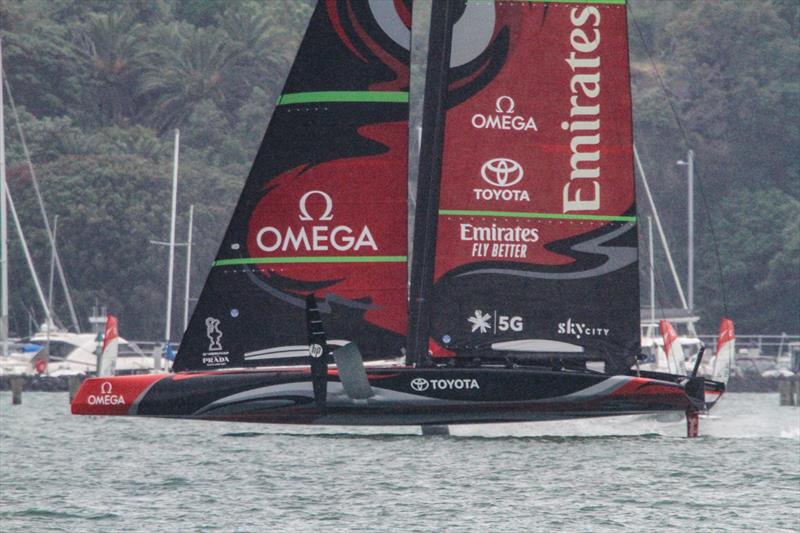
America's Cup: We have lift-off! How Te Aihe gets foiling
by Richard Gladwell/Sail-World.com/nz 22 Dec 2019 21:34 AEDT
22 December 2019

Te Aihe - Phases of Foiling - December 2019 © Richard Gladwell / Sail-World.com
In this series of images , taken through a long range lens (apologies for the graininess), we can see Emirates Team New Zealand's AC75 climb onto her foils while sailing from displacement mode, in a light breeze.
Normally the transition from displacement to foiling takes less than two seconds, and is hard to spot, but in the lighter breeze the transition takes place more slowly and we can see how Te Aihe's complex hull shape and foils work together to promote foiling.
The AC75's have three foils - two at the side and a third (a rudder wing) on the bottom of the rudder. Surprisingly the AC class rule doesn't put any restrictions on the rudder wing, but does specify the maximum depth for the rudder of 3.5metres.
Although the AC50 used in Bermuda had two daggerboard and two rudder wings, when foiling one of the daggerboards was retracted and the windward rudder wing was often not immersed either, and the AC50 flew on two foils - the same as the AC75.
(The one design AC50's used in the 2017 America's Cup specified a minimum rudder depth of 2.1 metres - the additional 1.4 metres of depth in the AC75 suggests that we are unlikely to see the rudder wing break clear of the water as happened many times in the 2017 AC, triggering some spectacular nosedives, and in ETNZ's case a potentially Cup ending pitchpole.)
There are no restrictions on the rudder wing in the AC75 class rule, in fact they aren't even mentioned in the Rule, yet every AC75 has one. They are an essential part of a foiling yacht. In the AC50 class they were restricted to 1.250m in span/length. As a safety measure, restrictions were introduced following the fatal Artemis Racing incident to reduce the chances of a crew member being struck by a rudder wing in a man overboard situation.
On the AC75, the rudder is permitted to be rotated, and can also be moved by yaw and rake. It is this last movement which controls the lift that can be induced in the rudder wing to lift the stern of the AC75. (The AC50's were only allowed 3 degrees of rake).
The two carbon foiling arms each have wings attached which in turn have flaps on their trailing edges, which can be trimmed to develop lift or control the flying height of the AC75.
In this set of images we can see the stage of flight in an AC75 from sailing in displacement mode, rising the bow and stern using the foils and then keeping even fore and aft trim, until the hull has fully cleared the water.
That should happen at the deepest point of the bustle - a design innovation on Te Aihe - and similarly on Luna Rossa's Prada.
It is important that the hull "levitates" in the foiling phase, as otherwise the the stern can drag, slowing the boat and inhibiting foiling.